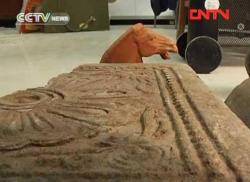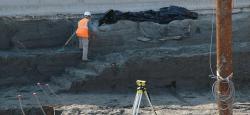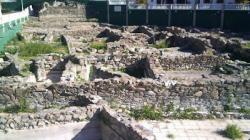INSTITUT SUPERIEUR D'ANTHROPOLOGIE
INSTITUTE OF ANTHROPOLOGY
ONLINE COURSES / COURS A DISTANCE
INSCRIPTION 2012 / Session II : Avril 2012
REGISTRATION 2012 / Term II : April 2012
CHINE –  Xi’an - Archaeologists in Shaanxi Province have discovered a historical site just outside Xi'an city. It's believed to be a large pottery kiln, dating back to the Tang Dynasty over 1,000 years ago. Let's do some digging. Local researchers found the ruins of the pottery kiln on a construction site in suburban Xi'an. And the first thing that surprised them was its size. Gao Bo, researcher from Xi'an Archaeology Research Inst., said, "We believe there are six caves jointed by one tunnel, so it's a large complex, because most kiln sites from the Tang Dynasty only have two or three caves." Also surprising was what they found in the kiln. All parts were unearthed at the same time and they include floor and wall tiles for a house building, ceramic bowls and pots. The surprising find was a clay horse, believed to be a funeral object. Gao Bo said, "For a kiln that mostly fired pottery pieces, the clay horse is such a rare find. We can see that it's very well designed and produced. " Although the kiln site lies near the ancient capital of the Tang Dynasty, there is no clear evidence whether it's an imperial kiln or civilian kiln. In any case, the site has provided new insight for historical studies on ancient pottery.
Xi’an - Archaeologists in Shaanxi Province have discovered a historical site just outside Xi'an city. It's believed to be a large pottery kiln, dating back to the Tang Dynasty over 1,000 years ago. Let's do some digging. Local researchers found the ruins of the pottery kiln on a construction site in suburban Xi'an. And the first thing that surprised them was its size. Gao Bo, researcher from Xi'an Archaeology Research Inst., said, "We believe there are six caves jointed by one tunnel, so it's a large complex, because most kiln sites from the Tang Dynasty only have two or three caves." Also surprising was what they found in the kiln. All parts were unearthed at the same time and they include floor and wall tiles for a house building, ceramic bowls and pots. The surprising find was a clay horse, believed to be a funeral object. Gao Bo said, "For a kiln that mostly fired pottery pieces, the clay horse is such a rare find. We can see that it's very well designed and produced. " Although the kiln site lies near the ancient capital of the Tang Dynasty, there is no clear evidence whether it's an imperial kiln or civilian kiln. In any case, the site has provided new insight for historical studies on ancient pottery.
http://www.kaogu.cn/en/detail.asp?ProductID=3363
FRANCE –  Antibes - En 2007, un diagnostic réalisé préalablement au projet de construction d’un parking souterrain sur l’emplacement du Pré aux Pêcheurs a montré que le site se trouvait à l’emplacement du port antique d’Antipolis. Une campagne de fouilles archéologiques préventives a donc été décidée afin de pouvoir étudier scientifiquement les vestiges situés sur l’emplacement du futur parking de 600 places sur 3 niveaux. Après la pose de la paroi moulée qui a permis de rendre étanche ce chantier situé sous le niveau de la mer, les fouilles archéologiques menées par l’INRAP ont débuté lundi. A priori, ces fouilles ne devraient pas donner lieu à des découvertes exceptionnelles puisqu’à l’époque romaine, la mer occupait le site qui n’abritait donc pas d’habitations. Les chercheurs s’attendent à trouver surtout des amphores, des poteries et tout ce qui pouvaient être jeter par-dessus bord des bateaux qui venaient s’arrimer dans ce port. Isabelle Daveau, la responsable de ces fouilles espère tout de même trouver des pièces rares comme des épaves de navires marchands romains. Les vestiges ramassés seront nettoyés puis emportés pour être étudiés par des spécialistes qui détermineront leur datation. Des travaux qui pourrait permettre d’évaluer avec précision la période de fondation de la ville grecque qui est encore assez incertaine, même si on l’estime à la fin du 6eou au début du 5e siècle avant notre ère, ce qui correspond à la grande période d’expansion de Marseille qui contrôlait tout le commerce maritime. Le début du chantier de fouilles archéologiques laisse déjà apparaître dans les niveaux supérieurs les vestiges d'une épave d'une barque datant sans doute du 17e siècle.
Antibes - En 2007, un diagnostic réalisé préalablement au projet de construction d’un parking souterrain sur l’emplacement du Pré aux Pêcheurs a montré que le site se trouvait à l’emplacement du port antique d’Antipolis. Une campagne de fouilles archéologiques préventives a donc été décidée afin de pouvoir étudier scientifiquement les vestiges situés sur l’emplacement du futur parking de 600 places sur 3 niveaux. Après la pose de la paroi moulée qui a permis de rendre étanche ce chantier situé sous le niveau de la mer, les fouilles archéologiques menées par l’INRAP ont débuté lundi. A priori, ces fouilles ne devraient pas donner lieu à des découvertes exceptionnelles puisqu’à l’époque romaine, la mer occupait le site qui n’abritait donc pas d’habitations. Les chercheurs s’attendent à trouver surtout des amphores, des poteries et tout ce qui pouvaient être jeter par-dessus bord des bateaux qui venaient s’arrimer dans ce port. Isabelle Daveau, la responsable de ces fouilles espère tout de même trouver des pièces rares comme des épaves de navires marchands romains. Les vestiges ramassés seront nettoyés puis emportés pour être étudiés par des spécialistes qui détermineront leur datation. Des travaux qui pourrait permettre d’évaluer avec précision la période de fondation de la ville grecque qui est encore assez incertaine, même si on l’estime à la fin du 6eou au début du 5e siècle avant notre ère, ce qui correspond à la grande période d’expansion de Marseille qui contrôlait tout le commerce maritime. Le début du chantier de fouilles archéologiques laisse déjà apparaître dans les niveaux supérieurs les vestiges d'une épave d'une barque datant sans doute du 17e siècle.
http://www.webtimemedias.com/article/pre-aux-pecheurs-c%E2%80%99est-parti-pour-6-mois-de-fouilles
GRECE –  - Greek archaeologists appealed to art lovers across the world on Wednesday to protest against austerity cuts taking a toll on the debt-stricken country's ancient monuments, temples and museums. Since the debt crisis flared in 2009, Greece has imposed a series of spending cuts to satisfy lenders and avert bankruptcy. The culture ministry's budget has been cut by 35 percent and it has axed 2,000 staffers, mostly workers on temporary contracts. The budget cuts have hit museums and archaeological sites hard, forcing some to shorten visiting hours or shut down and prompting concern about the level of security at some of the most precious archaeological sites. "Our cultural heritage is not for sale," said Despina Koutsoumba, the head of the Greek Archaeologists' Association. "We don't want markets to rule over our cultural heritage, our history and our democracy." She and other Greek archaeologists called on art lovers to protest the cuts by holding up posters reading "Defend Greece's Cultural Heritage" in front of Greek statues in museums abroad, and posting pictures of the picketing the Internet.
- Greek archaeologists appealed to art lovers across the world on Wednesday to protest against austerity cuts taking a toll on the debt-stricken country's ancient monuments, temples and museums. Since the debt crisis flared in 2009, Greece has imposed a series of spending cuts to satisfy lenders and avert bankruptcy. The culture ministry's budget has been cut by 35 percent and it has axed 2,000 staffers, mostly workers on temporary contracts. The budget cuts have hit museums and archaeological sites hard, forcing some to shorten visiting hours or shut down and prompting concern about the level of security at some of the most precious archaeological sites. "Our cultural heritage is not for sale," said Despina Koutsoumba, the head of the Greek Archaeologists' Association. "We don't want markets to rule over our cultural heritage, our history and our democracy." She and other Greek archaeologists called on art lovers to protest the cuts by holding up posters reading "Defend Greece's Cultural Heritage" in front of Greek statues in museums abroad, and posting pictures of the picketing the Internet.
http://www.msnbc.msn.com/id/46735408/ns/technology_and_science-science/#.T2I8MBEaMyp
UAE – Al-Dour - Sheikh Saud bin Rashid Al Mu'alla, Supreme Council member and ruler of Umm al-Qaiwain viewed new discoveries from the Al-Dour archaeological site in the emirate. During his visit to the Department of Archaeology and Heritage in Umm Al Qaiwain, Sheikh Saud was briefed on the ancient stone graveyard which is 5X6 meters and houses a skeleton, a bronze ring, agate and glass beads, a large jar containing a small glazed-pottery dish,, iron arrow, and dagger blades. The discoveries date back to 1 AD and 2 AD.
http://www.wam.org.ae/servlet/Satellite?c=WamLocEnews&cid=1289998019272&p=1135099400124&pagename=WAM%2FWamLocEnews%2FW-T-LEN-FullNews
CANADA –  Nunavut - A hearing on Thursday will decide the fate of a ship once captained by Roald Amundsen, the Norwegian explorer first to reach the south pole. The Maud is partially sunk in Cambridge Bay in Nunavut, northern Canada. A permit to return the ship to Norway was denied in December and Canadian officials have argued the ship is crucial to the nation's heritage. Called Maud Returns Home, the project would see the wreck towed back to Norway to become a museum near Oslo. Amundsen was using the ship to sail through the Northeast Passage between 1918 and 1920 but was unable to launch an expedition to the north pole from there. The ship was sold to the Hudson's Bay Company and became a warehouse and radio station before sinking in 1930.
Nunavut - A hearing on Thursday will decide the fate of a ship once captained by Roald Amundsen, the Norwegian explorer first to reach the south pole. The Maud is partially sunk in Cambridge Bay in Nunavut, northern Canada. A permit to return the ship to Norway was denied in December and Canadian officials have argued the ship is crucial to the nation's heritage. Called Maud Returns Home, the project would see the wreck towed back to Norway to become a museum near Oslo. Amundsen was using the ship to sail through the Northeast Passage between 1918 and 1920 but was unable to launch an expedition to the north pole from there. The ship was sold to the Hudson's Bay Company and became a warehouse and radio station before sinking in 1930.
http://www.bbc.co.uk/news/science-environment-17364684
ESPAGNE –  Turaniana - The ‘Unidos por Turaniana’ Group has reported illegal excavations at the archaeological site of Turaniana in Roquetas de Mar. The complaints have been made to the Environmental Prosecutor and the Culture Delegation after evidence of digging in the Torre Quebrada area was detected. Parts of the tower had been removed and the damage had been hidden with vegetation. The group considers that such activity “seriously damages the valuable local historical and archaeological heritage” and could be considered a very serious crime according to the Andalucian Historical Heritage Law. They have therefore requested an investigation into the events and are demanding more protection for the site.They have also asked that the archaeological remains be signposted to that local residents are aware of their importance.
Turaniana - The ‘Unidos por Turaniana’ Group has reported illegal excavations at the archaeological site of Turaniana in Roquetas de Mar. The complaints have been made to the Environmental Prosecutor and the Culture Delegation after evidence of digging in the Torre Quebrada area was detected. Parts of the tower had been removed and the damage had been hidden with vegetation. The group considers that such activity “seriously damages the valuable local historical and archaeological heritage” and could be considered a very serious crime according to the Andalucian Historical Heritage Law. They have therefore requested an investigation into the events and are demanding more protection for the site.They have also asked that the archaeological remains be signposted to that local residents are aware of their importance.
http://www.euroweeklynews.com/news/costa-de-almeria/91644-group-demands-more-protection-for-turaniana-archaeological-site